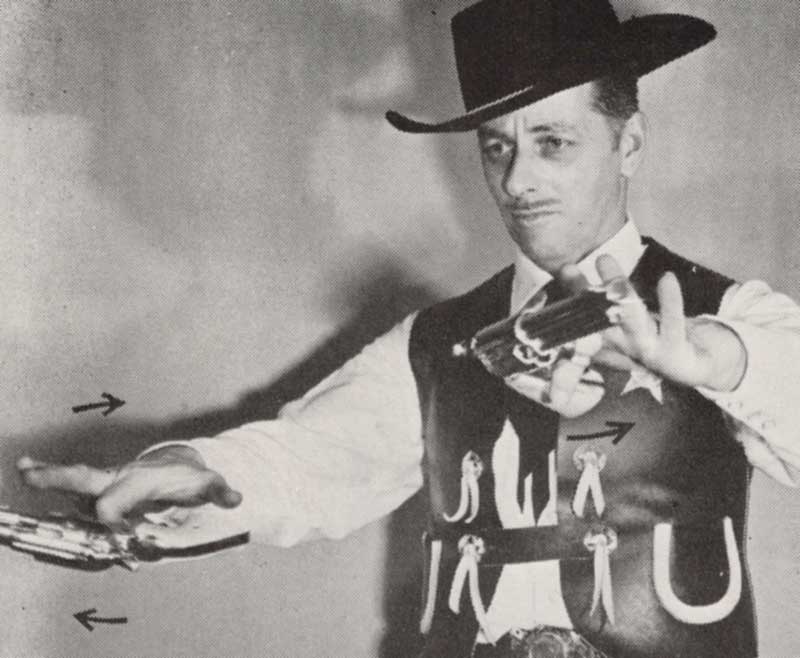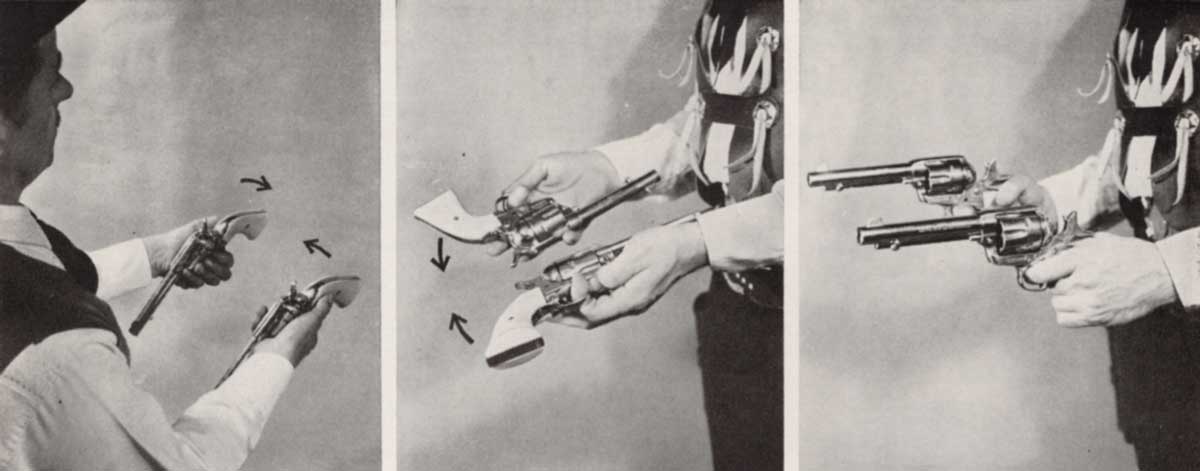The gunslingers of the old west always had some trick or method they used to gain an advantage over an opponent in a gunfight. Sometimes they worked…other times they did not.
Back in 1962, George Virgines wrote an article on the Gun Tricks of the Old West. In it, he specifically addressed the insider tricks of the trade to improve your odds of survival in the outlaw days.
Here is an excerpt from the original piece that talks about cowboy holsters.
Gun Tricks of the Old West
Styles change from year to year in stories about the gun feats of the old western gunmen. One writer, or the writers of one period, tell tales that range from tall to utterly impossible, all sworn to as fact beyond question. Another writer, or the writers of another year, jump with calked boots on one of the impossible stories, disprove it, sneer at it, and leap from that to the conclusion that all the stories are false or even that there never was any such thing as a western gunfighter, good or bad.

But there were men – more men than you know, because many of them never got or would not permit the publicity given to others – who staked their lives on their gun-skills, and some of those men survived too many such gambles to leave room for doubt that their skills were real. One writer “debunked” the whole gunfighter legend by stating that “such skill could not have been attained without long practice, and these men never practiced.”
Practice and More Practice
Who says they never practiced? Breckinridge practiced; he said so himself. Men who knew Billy the Kid say that he practiced, with rifle and revolver; that he dearly loved “a shooting match” – for fun, not for blood.
Wyatt Earp practiced; liked to let himself be “talked into” impromptu exhibitions of marksmanship, on the theory that men who saw him shoot might be dissuaded from challenging him in earnest. Hickok practiced; not one of his contemporary biographers fails to mention his unfailing willingness to engage in shooting matches and exhibitions. John Wesley Hardin practiced; read his autobiography.
Why wouldn’t they practice? What man who expected to stake his life on his gun skill would fail to develop that skill to the utmost? And anyway, guns were a part of the life of the era. The impromptu shooting match was as common as the impromptu horserace.
Men practiced endlessly for new ways for better accuracy or greater speed. Holsters and gun-hangers were invented, each calculated to give a man some “edge” in a gunfight. Guns of all types, from tiny derringers to sawed-off shotguns, were tried, touted, or discarded. Triggers of single-action revolvers were removed or tied back, and “slip-hammers” added. Every top gunman insisted that speed was less important than making the first shot count, but every one of them worked to be able to make that first shot as sudden as possible – in a “sort of a slow hurry,” to quote a phrase that became famous.
Cowboy Holsters
It was a common practice of the old gunslinger to work over his pistol to give the “edge” in getting that first shot off. Almost invariably, the gun would be the Colt Single Action Army revolver, sometimes known as the Frontier model.
The design gave the gun perfect balance, easy to draw and handle. Its large hammer made for easy cocking, the grip would fit just about any hand, and the small trigger guard made for easy spinning. Among the numerous alterations committed by the gunman to this weapon were-filing off part of the trigger guard, removing the trigger or tying it back, replacing the standard hammer with a Bisley Colt -hammer for better thumb traction. They weakened the hammer spring, and they removed the front sight “to keep it from snagging in the holster.”
Metal Plate or Pivot Holster
One unique idea for carrying a gun without a holster was used by the famous Texas Ranger, Jim Gillett. A metal plate was slotted and riveted to a belt, and the hammer screw of the Colt Single Action was replaced with a large-headed screw that fitted into the T slot in the plate. The pistol was pushed back until the large-headed screw would fall into a slight depression at the rear of the slot. The gun would hang there and swing easily. To shoot the gun, it could be removed from the slot or simply pivoted and fired.
The Hardin Holster Vest
John Wesley Hardin, the “preacher’s boy” from Texas, designed what he called a “holster vest,” later ‘called the “Hardin vest.” It was a skeleton-type vest, made from calfskin, and it had two holster pockets slanting toward the front. The guns were carried with the butts forward for a cross draw. But this holster vest never gained any popularity with the gunslingers.
Cowboy Swivel Holsters
Another type of trick holster that never reached any degree of popularity was the swivel type. The holster was attached to the belt by means of a leather tap and a swiveling rivet. All the gunman had to do was to push the pistol butt down and bring up the barrel and fire through an opening at the bottom of the holster. Like the slot-and-stud naked-gun carry of Jim Gillett, this pivoted holster limited the area of fire, preventing a shot much to the left or right.
Invention of the Shoulder Holster
Gunmen were an ingenious lot. Ben Thompson, another Texan, according to tradition, invented the shoulder holster which could be worn under the coat and conceal the weapon. This style holster is still popular today, and many variations and improvements have been made to suit the individual taste.
First Pocket Holster?
Dallas Stoudenmire, a two-gun marshal of El Paso, Texas, simplified the carrying of two guns by having leather-lined hip pockets tailored into his pants. The story goes that he could produce his six-shooters from these pockets with lightning speed.
While Stoudenmire was likely not the first man to carry a gun in his pocket, tailoring leather holsters into the pockets may have been unique to him. In that case, he may have been the originator of the modern pocket holster.
